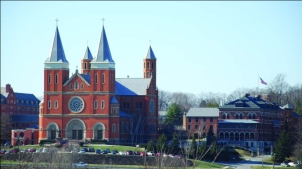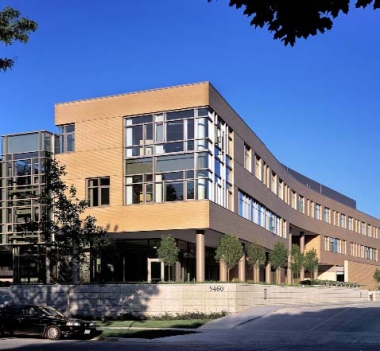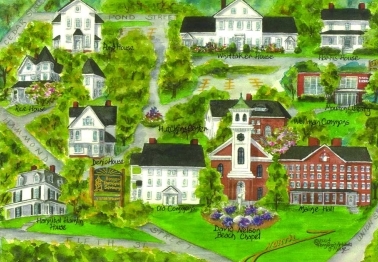Nestled in the foothills of the Alleghenies of western Pennsylvania, Saint Vincent Seminary is a picturesque, nearly movie-set-perfect depiction of theological education. Traditional brick buildings, some built by pioneer monks who founded the seminary in 1846, blend with newer ones constructed after a fire in the 1960s. Two 55-foot spires from the archabbey basilica reach into the blue skies, while robed monks share the 1,800-acre campus with sweatshirted undergrads from Saint Vincent College.
Originally founded to train clergy for German Catholic immigrants, Saint Vincent was the first Benedictine institution in the United States. Today 100 seminarians from 16 dioceses, seven Benedictine monasteries and numerous other religious congregations study for the priesthood and lay ministry. Although the monks live separately from the other seminarians, their residences are connected by a joint hallway, a physical symbol of the need to connect all students to the Benedictine model of work, prayer, and community living.

|
|
Benedictine monks take vows of stability, conversion of life, and obedience. At Saint Vincent, as at other Benedictine communities, "stability" signifies a commitment to a place and the people who live there over many generations. As seen here, the basilica's prominence indicates its importance to the community.
(Photo courtesy of Saint Vincent Seminary)
|
"It's important for our students to share in our sense of Benedictine life and mission," says Father Justin Matro, rector of the seminary. "They may not make 6 a.m. morning prayer with the monks-- 7:30 comes early enough for students!--but they often attend daily prayer, and share weekly prayer together."
Board member Maureen Lally-Green, a Superior Court judge in Pennsylvania, likens the Benedictine essence of the place to an umbrella. "This sense of hospitality, of prayer, of hard work is over all we do," she says. "When you walk on the campus, you do feel the spirituality that's there."
Saint Vincent Seminary's location--near the monastery, connected to a larger college and in an insulated corner of the Appalachian region --is essential to its identity, history, and mission. But many theological schools have recently been on the move, either because of financial need or external circumstance. (For example, a highway expansion is requiring the relocation of Newman Theological College and St. Joseph Seminary in Edmonton, Alberta. See the New Year 2008 issue of In Trust, page 21.)
When the prospect of a move looms on the horizon, boards have to face serious issues related to financial viability. But they must also grapple with how a move might affect a school's mission. In what way are a school's location, property, and buildings part of that mission? And what happens to a seminary's identity when its location conflicts with the financial realities? How much does location determine a seminary's understanding of itself and its purpose?
In the past, across many traditions, theological schools were purposefully located in the country, away from the distractions of the world, to encourage contemplation and reflection. In other traditions, most seminaries were established in large cities, in the population centers that supplied new students year after year. People at Saint Vincent believe they have the best of both worlds, with a feeling of insulation yet with access to the college, which has become a cultural hub in the area, and to nearby Pittsburgh, which is less than an hour's drive away. "We do believe that it's good for seminarians to have the space for a period of intense reflection to consider their vocation," says Matro. "Yet it's also a life for service and ministry to the community."
Because service to the community is so important, the board has initiated a Pastoral Stewardship Program, which brings in experts once a semester to enlighten the seminarians on nuts-and-bolts topics like employment law, how to keep the books, and how to lead and inspire people. "The goal is to best prepare them to be effective leaders in their communities," says Lally-Green, "since Jesus was a leader in his community."
Down on the farm
Responding to the needs of the community is also what led to the founding of Briercrest Bible Institute in 1935, after a women's Scripture study encouraged a group from this farming community in southwestern Saskatchewan to start a church and a Bible school. When the school outgrew the town's facilities after World War II, it purchased an old British training airbase in nearby Caronport. Today Briercrest College and Seminary, along with a sister high school, remain committed to serving rural western Canada.
"The land has formed this school," says Dr. Dwayne Uglem, president of the nondenominational, evangelical college and seminary, who is himself a Briercrest graduate. "We have a deep commitment to Saskatchewan. This province has stood behind us."

|
|
The Briercrest family of schools in rural Caronport, Saskatchewan, includes more than 1,000 students on its 160-acre campus - from kindergartners through master's students in theology. "Since we live in the midst of tribal lands, we have a desperate responsibility to know the story of the original inhabitants of this land," says President Dwayne Uglem.
(Photo courtesy of Briercrest College and Seminary)
|
Within a province of only one million people, the Briercrest schools attract more than 1,000 students each year, including 150 seminarians. As more and more rural Canadians move to urban centers, even Uglem admits that "it doesn't make any sense" that so many students would be attracted to a small community on the prairie. Yet students and alumni come to appreciate the rural location. "It usually takes one semester and they fall in love with the place," says board chair John Krahn, president and chief executive of Geo-Slope International in Calgary, Alberta. "And after you have had a lifetransforming experience there, you see the value in the location."
Although surrounded by wheat fields, the 160- acre campus claims the largest church auditorium in the province--the 2,400-seat Hildebrand Chapel. And with an elementary school on the campus, Briercrest boasts that it's one of the only places in the world where a Christian education is offered from kindergarten to the master's level, all within walking distance. In addition, the Trans-Canada Highway provides access to nearby Moose Jaw (population 34,000) and Regina (population 200,000).
Yet the relatively remote location does have its challenges. Travel can be difficult for board members, with the nearest airport in Regina, about an hour's drive away. But the board is committed to meeting on campus, and Krahn suggests that hour-long commutes to and from airports are not unusual in urban areas, either.
It can be difficult to attract faculty and staff from larger schools, and relocation was a concern for some candidates during a presidential search four years ago, Krahn says. Luckily the leading candidate was a Briercrest graduate who already appreciated the benefits of the rural location. "I grew up in a small town near Alberta, so I've moved from a town of 300 to a town of 900," says Uglem. His wife, Janell, also a Briercrest grad, grew up on a farm.
President Uglem has led an effort to re-emphasize Briercrest's location and connection to the community. "We are trying to approach what it means to be where we are in new ways," he says. "Since we live in the midst of tribal lands, we have a desperate responsibility to know the story of the original inhabitants of this land. They're going to teach us about the importance of this geography."
City slickers
While Briercrest's mission is to train rural pastors (many of whom can drive a tractor as well as any of their congregants), McCormick Theological Seminary in Chicago has been equally committed to its mission to train pastors prepared to minister in urban and suburban communities. In its 177- year history, McCormick Theological Seminary has moved three times, with its mission as an urban seminary visible from the beginning.
The first move, in 1849, was from the frontier town of Hanover, Indiana down the Ohio River to New Albany, then the largest city in Indiana. By 1859, Chicago had become the Midwest's strategic center, so the school relocated to Lincoln Park, a predominantly German neighborhood just north of the city and, at the time, still remote enough to host the city's cemetery and smallpox hospital. With 25 acres donated by a brewer and railroad businessmen, the seminary became one of the neighborhood's largest landowners.
McCormick's current home in Chicago's Hyde Park neighborhood, about 10 miles away from Lincoln Park, was the result of a decision in 1975 to join the Chicago Cluster of Theological Schools and provide a more ecumenical focus, sharing facilities with the Lutheran School of Theology and the now-closed Jesuit School of Theology. Proximity to the renowned University of Chicago was also an academic plus. The move also strengthened the school financially, which was good news since it was facing decreased denominational funding. The approximately $6 million gained from the sale of the Lincoln Park facilities to DePaul University were redirected toward endowment and made a balanced budget possible for all but one of the years between 1976 and 1985.

|
|
McCormick Theological Seminary has always had an urban focus. "An awful lot of life and human interaction happens in cities, so this is a place for theological education," says former board chair John Buchanan.
(Photo courtesy of McCormick Theological Seminary)
|
"It was a bold move, and it was hard for people who had been on the old campus and loved it," says the current president, the Rev. Cynthia Campbell. "But it was the right thing to do."
The move to Chicago's South Side also prompted an outreach to the predominantly African American community surrounding Hyde Park. Today, 35 percent of McCormick students are black and only 48 percent are non-Hispanic white. "We do not have a majority race in our master's program," notes Campbell.
In addition, half the seminarians at McCormick are not Presbyterian, a demographic reality the school attributes to its urban identity, though this reflects a widespread trend in Protestant theological schools. "We push way beyond the Reformed household, which really stretches us," says Deborah Kapp, who teaches urban ministry. "It's just part of who we are, by being where we are."
Courses in "The Church and Social Change" and "Black Christianity" include visits to a variety of churches throughout Chicago and provide context for future urban pastors. President Campbell says McCormick students study their urban context as closely as any required textbook. "We try to help people understand their neighborhood and their allies," she says. "Those skills are important regardless of where you go."
Professor Kapp agrees. "If I were teaching rural ministry, I'd be teaching the same skills, but they would be experienced and tested out in different contexts."
One drawback to urban seminary education is cost, with nearly everything--from housing to salaries to maintenance--costing more in urban areas. "It is expensive to live and work in cities," Campbell says. Yet being located in an urban center can be a strength, too. McCormick's urban identity and diversity are a plus for recruitment, says the Rev. John Buchanan, who served as McCormick's board chair from 2002 to 2006.
Chicago's attractions, from its lakefront parks to its smorgasbord of international restaurants, are well known to Buchanan, pastor of Fourth Presbyterian Church on Chicago's famed Magnificent Mile. But it is more than the typical tourist options that lure students to McCormick. The possibility of cross-registration at nearby seminaries, the academic environment of the University of Chicago, and the palpable energy of the city are all significant draws. "
An awful lot of life and human interaction happens in cities, so this is a place for theological education," says Buchanan. "This is where human life is lived. We need to be a part of that."
Home is where your heart is
If the importance of a seminary's location-- whether urban or rural--cannot be denied, it doesn't always have to define a school's identity and mission, especially in a world where teleconferencing and telecommuting have redefined how people interact. Reading those signs of the times, Bangor Theological Seminary in Maine made radical changes to its location and its identity, leaving a traditional, historic campus in Bangor to lease two locations more than 100 miles apart. It's starting to rebrand itself as a regional school that serves northern New England.

|
|
Three years ago, Bangor Theological Seminary sold its historic campus (depicted here) to complete its repositioning as a regional seminary with two smaller, leaner locations - including one in the growing city of Portland. President William C. Imes understands the tendency to elevate a school's location as "holy ground", but he believes that a too-close identification with real estate can prevent seminaries from moving into the future.
(Image courtesy of Fernwood Artworks of Maine)
|
"We don't own anything but books, and perhaps we won't need to own those in the future," says seminary president William C. Imes, who is retiring this year. "I think the Internet and technology are going to make us all reconsider the importance of location."
Even Bangor's chapel space, with moveable seating and furniture, reflects the flexibility of the ecumenical school, which, although associated with the Congregationalist tradition within the United Church of Christ, includes students and faculty from more than a dozen religious traditions.
While Imes understands the tendency to elevate a school's location as "holy ground," he believes that a too-close identification with real estate can prevent seminaries from moving into the future. "I think that appreciation for and devotion to a sense of place don't serve seminaries well now," he says. "It's addressing today's problem with yesterday's solution."
Instead seminaries must go where students are, rather than expecting them to come to them, says Imes. That's what Bangor did in 1991, when former president Malcolm Warford noticed that Bangor, already known for serving second-career seminarians, was attracting even more commuter and parttime students. So while keeping its base in Bangor, the seminary opened two new campuses, one each in Portland, Maine, and Hanover, New Hampshire. Although the Hanover campus closed seven years later, the Portland campus has flourished, says Imes.
Bangor, which is Maine's third largest city and a former lumber port that is still surrounded by heavy forests, has been affected by the population decline in northern Maine. In contrast, Portland, the state's largest city, is growing, younger and more diverse. "Clearly we had to make a move to be where the students are," says Imes, who travels the interstate that connects the two cities to teach preaching at both locations.
Three years ago, in an effort to cut costs, the school sold its Bangor campus to developers and moved into leased space at nearby Husson College. Although the decision by the board was unanimous, the process of making it was long, wrenching and controversial. As trustee Jane Bragg told the Bangor Daily News in 2005, "It's been obvious for a while that we couldn't continue to support financially that large a campus. This is a problem that other seminaries have had. We, as a board, decided to be proactive to preserve and enhance the mission of the program we have."
Yet three years later, Imes believes being a tenant offers benefits other than the financial. Although the seminary and Husson College are separate, there is the possibility of joint offerings, particularly with Husson's master's program in school counseling. And while some Bangor students long for some "private" space on the new campus and opportunities for a more cloistered experience, others see the largely unchurched Husson undergrads as opportunities for hands-on evangelization. "They say, 'This is cool. If we're going to minister to young people, we've got 2,000 people to practice on,'" says Imes.
It remains to be seen if students will eventually become emotionally attached to the Husson and Portland campuses, yet Imes claims that theological education is ultimately about people and relationships, not place.
Leaders at other theological schools continue to insist that location is essential to their identities, but all can certainly agree that furthering a school's mission while maintaining economic vitality is a complex challenge. Boards have the joy of living in the creative tension--preserving and furthering the ultimate purposes of the school while attending to fiduciary matters with due diligence.